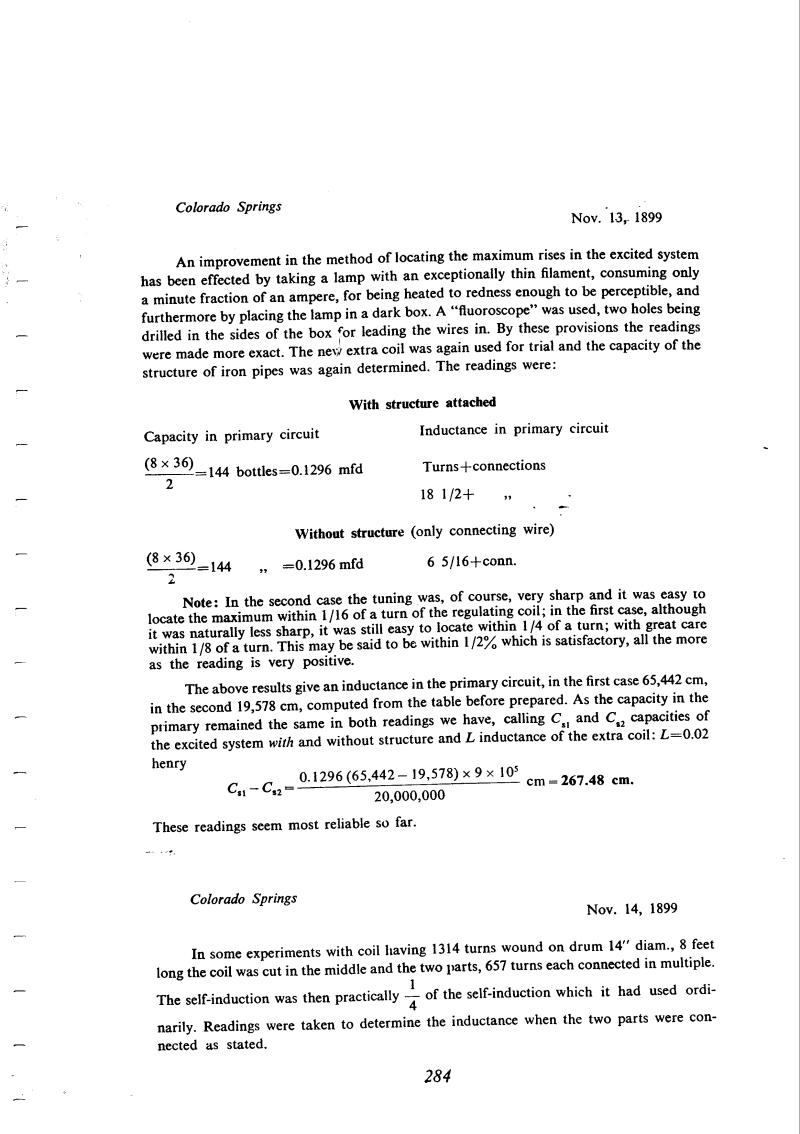
Nikola Tesla Books
Colorado Springs
Nov. 13, 1899
An improvement in the method of locating the maximum rises in the excited system has been effected by taking a lamp with an exceptionally thin filament, consuming only a minute fraction of an ampere, for being heated to redness enough to be perceptible, and furthermore by placing the lamp in a dark box. A âfluoroscopeâ was used, two holes being drilled in the sides of the box for leading the wires in. By these provisions the readings were made more exact. The new extra coil was again used for trial and the capacity of the structure of iron pipes was again determined. The readings were.
| With structure attached | |
| Capacity in primary circuit | Inductance in primary circuit |
| $! {{\left({8 \times 36}\right)} \over 2} $! = 144 bottles = 0.1296 mfd | Turns + connections |
| 18 1/2 + " | |
| Without structure (only connecting wire) | |
| $! {{\left({8 \times 36}\right)} \over 2} $! = 144 " = 0.1296 mfd | 6 5/16 + conn. |
Note: In the second case the tuning was, of course, very sharp and it was easy to locate the maximum within 1/16 of a turn of the regulating coil; in the first case, although it was naturally less sharp, it was still easy to locate within 1/4 of a turn; with great care within 1/8 of a turn. This may be said to be within 1/2% which is satisfactory, all the more as the reading is very positive.
The above results give an inductance in the primary circuit, in the first case 65,442 cm, in the second 19,578 cm, computed from the table before prepared. As the capacity in the primary remained the same in both readings we have, calling Cs1 and Cs2 capacities of the excited system with and without structure and L inductance of the extra coil: L = 0.02 henry
Cs1 - Cs2 = $! {{0.1296(65,442 - 19,578) \times 9 \times 10^{5}} \over 20,000,000} $! cm = 267.48 cm.
These readings seem most reliable so far.
Colorado Springs
Nov. 14, 1899
In some experiments with coil having 1314 turns wound on drum 14" diam., 8 feet long the coil was cut in the middle and the two parts, 657 turns each connected in multiple. The self-induction was then practically $! {1 \over 4} $! of the self-induction which it had used ordinarily. Readings were taken to determine the inductance when the two parts were connected as stated.
284
November 13
Tesla uses an improved method for determining the resonance point, with the light bulb in a dark box for more precise detection of luminance, and determines the capacity of the iron piping once more, obtaining a value about 10% less than in earlier measurements (see November 7th and 12th).
November 14
He measures the coil with 1314 turns but so that two coil halves are connected together in parallel. He expects that the connection of two halves in parallel should provide one quarter of entire coil inductance, which is approximately obtained in this case because the ratio 1/d of the tested coil is fairly large (please see Nov. 10). He performed the measurement at the frequency of 140 Hz, similar to Nov. 10) when he measured the entire coil inductance. The measured value is four times larger now and amounts to 83,524,000 cm and the previous measurement of the entire coil provided 85,000,000 cm. The small difference proves Tesla's claim that the inductance is almost four times larger.

